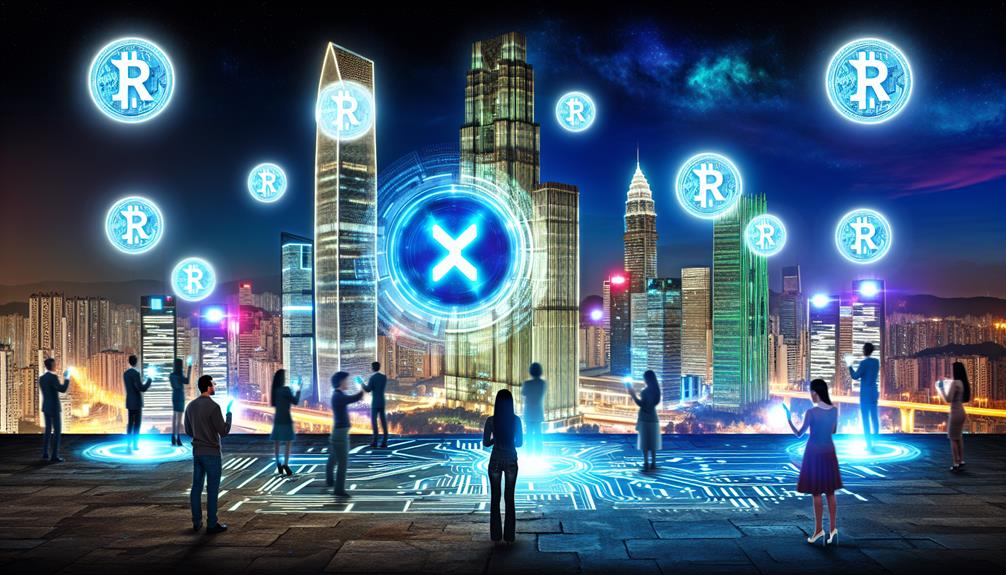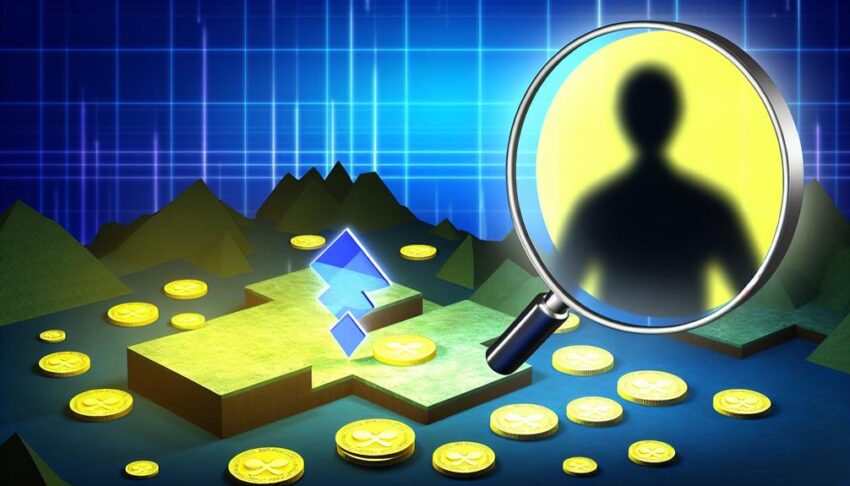When you look into the world of XRP, it's hard to ignore the swirling accusations labeling it a scam. Critics often point to concerns about its centralization and the ongoing legal battles with the SEC, which paint a picture of instability. Yet, there's a dedicated community that touts XRP's potential for revolutionizing cross-border payments. So, what's the truth behind the allegations? Is there a deeper narrative that could change your perspective on this cryptocurrency? The answers might surprise you.
Overview of XRP

XRP is a digital asset designed primarily for facilitating cross-border payments and enhancing the efficiency of international money transfers. Its underlying technology, the XRP Ledger, operates on a decentralized protocol that enables secure and quick transactions. Unlike traditional banking systems that can take several days to process international payments, XRP transactions are confirmed in a matter of seconds, greatly reducing the time and cost associated with transferring funds globally.
When you explore XRP adoption, you'll find that financial institutions and payment providers are increasingly incorporating XRP technology into their operations. For instance, companies like Ripple, which developed XRP, have partnered with various banks and payment networks to streamline their cross-border payment processes. This trend suggests a growing recognition of XRP's potential to enhance liquidity and reduce transaction fees.
Data indicates that XRP has achieved considerable traction within the remittance industry. According to various reports, the volume of XRP used in payment corridors has steadily increased, reflecting a shift towards more efficient digital asset solutions. Furthermore, the scalability of XRP technology allows it to handle a high number of transactions per second, making it a viable alternative to traditional banking infrastructures.
Common Scam Allegations
Concerns about potential scams in the cryptocurrency space often surface when discussing XRP. One of the primary scam allegations revolves around the lack of transparency regarding its centralization. Unlike many cryptocurrencies that promote decentralization, XRP's governance is often seen as being controlled by Ripple Labs, which raises fraud indicators for some investors. This centralization can lead to questions about manipulation and the long-term viability of the asset.
Another common allegation is the aggressive marketing tactics employed by Ripple and its affiliates, which some critics argue create unrealistic expectations for returns. This type of marketing can exacerbate investment risks, as it may entice individuals to invest without a thorough understanding of the underlying technology and its potential limitations. In addition, the volatility of XRP's price often attracts speculation, which can be a red flag for potential fraud.
Additionally, some investors have pointed to the lack of a clear regulatory framework surrounding XRP, which can heighten concerns about its legitimacy. The absence of detailed guidelines can create an environment where scams may flourish, making it essential for potential investors to conduct due diligence.
Legal Challenges and Outcomes

How have legal challenges shaped the perception of XRP in the cryptocurrency market? The ongoing legal battles involving Ripple Labs, the company behind XRP, have notably influenced how investors and regulators view the digital asset. In December 2020, the U.S. Securities and Exchange Commission (SEC) filed a lawsuit against Ripple, claiming that XRP is an unregistered security. This legal confrontation prompted widespread concern about the regulatory implications for XRP and other cryptocurrencies.
Market reactions to these challenges have been volatile. Initially, the news led to a sharp decline in XRP's price as exchanges like Coinbase and Binance halted trading. However, as the case progressed, some market participants began to speculate on potential outcomes that could favor Ripple. A notable moment occurred when a federal judge ruled that Ripple's sales to institutional investors might constitute securities, while sales to the general public did not—a decision that injected a degree of optimism into the market.
Despite the mixed rulings, uncertainty remains. Ongoing litigation raises questions about the future of XRP and its regulatory status. This unpredictability can sway investor sentiment and market stability. As you consider XRP's position in the cryptocurrency landscape, it's essential to keep an eye on the legal developments and their broader implications for market dynamics. The intersection of law and crypto is complex, and the outcomes of these legal challenges will likely reverberate throughout the industry for years to come.
Community Perspectives
The legal challenges surrounding XRP have not only impacted its market performance but also shaped the community's perspectives on the asset. As these issues unfolded, users began voicing their concerns, leading to a mix of skepticism and loyalty within the XRP community. This dichotomy reflects a broader spectrum of user experiences that can be categorized into three key themes:
- Trust in Technology: Many users believe in the underlying technology of XRP and its potential to revolutionize cross-border transactions, despite regulatory uncertainties.
- Financial Security: Some community members express anxiety over their investments, fearing that ongoing legal issues may lead to significant financial losses or even the project's collapse.
- Advocacy for Clarity: A portion of the community seeks clearer communication from Ripple Labs, emphasizing the need for transparency regarding regulatory status and future plans.
These community concerns illustrate a tense relationship with XRP as participants navigate the uncertainty surrounding its legality. Data from social media and forums indicate that while some users remain optimistic about XRP's long-term viability, others are increasingly disillusioned. This division suggests that user experiences are highly influenced by individual perspectives on risk and reward. Ultimately, the community's sentiment toward XRP hinges on the evolving legal landscape and the asset's ability to deliver on its promises amidst challenges. Understanding these perspectives is vital for anyone considering involvement in the XRP ecosystem.
Evaluating XRP's Future

Steering through the complexities of XRP's future requires a careful analysis of both market dynamics and regulatory developments. As an investor or enthusiast, you'll want to keep an eye on how these factors influence XRP adoption and overall market trends.
Recent regulatory decisions, such as those from the SEC, will play a significant role in shaping XRP's trajectory. If XRP is deemed a security, it could face restrictions that hinder its use in the market. Conversely, a favorable ruling could boost investor confidence and adoption rates.
Here's a breakdown of key factors influencing XRP's future:
| Factor | Impact on XRP Adoption | Current Market Trend |
|---|---|---|
| Regulatory Clarity | High | Increasing interest post-ruling |
| Institutional Interest | Medium | Gradual integration of crypto assets |
| Technological Advancements | High | Enhanced transaction speed and efficiency |
| Global Partnerships | High | Expanding use cases in finance |
| Market Sentiment | Variable | Fluctuating based on news and events |
As you evaluate XRP's future, consider these elements. The interplay between regulatory developments and market trends will be vital. By staying informed and analyzing these factors, you can better assess the potential for XRP adoption and its place within the broader cryptocurrency landscape. Always remember that the crypto market is volatile, and thorough research is essential for making informed decisions.
Frequently Asked Questions
How Does XRP Compare to Bitcoin and Ethereum?
When you compare XRP to Bitcoin and Ethereum, you'll notice differing adoption trends and market volatility. XRP's focus on transaction speed contrasts with Bitcoin's scarcity and Ethereum's smart contracts, influencing their respective market dynamics.
What Is Ripple's Role in the XRP Ecosystem?
When it comes to Ripple's role in the XRP ecosystem, you'll find it's all about enhancing transaction speed and liquidity, facing regulatory challenges, fostering financial partnerships, and driving market adoption for overall ecosystem growth.
Can I Buy XRP With Fiat Currency?
Yes, you can buy XRP with fiat currency through various XRP exchanges. These platforms facilitate fiat conversion, allowing you to trade traditional currencies for XRP efficiently, provided you follow the necessary regulations and verification processes.
What Wallets Support XRP Storage?
When it comes to storing XRP, "a stitch in time saves nine." You've got various wallet types—hardware options for security, software reviews for accessibility, and mobile wallets ensuring security. Choose wisely based on your needs.
Are There Tax Implications for Trading Xrp?
When trading XRP, you should consider its taxation implications. Tax reporting requirements vary by jurisdiction, and understanding trading regulations is essential for compliance. Always evaluate investment implications to avoid unexpected tax liabilities in your trading strategy.
Conclusion
In evaluating XRP, it's essential to weigh the allegations against its potential. While concerns about centralization and regulatory scrutiny linger, many believe in its technology's promise for seamless cross-border transactions. As legal battles unfold, understanding the nuances of these challenges is vital. Whether you view XRP as a scam or a legitimate asset, staying informed and conducting thorough research can guide your investment choices and shape your perspective on its future in the market.
